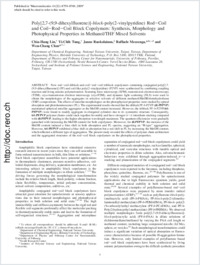Poly[2,7-(9,9-dihexylfluorene)]-block-poly(2-vinylpyridine) rod−roil and coil−rod−coil block copolymers: synthesis, morphology and photophysical properties in methanol/THF mixed solvents
- Lin, Chia-Hung Department of Chemical Engineering, National Taiwan University, Taipei, Taiwan
- Tung, Yi-Chih Department of Chemical Engineering, National Taiwan University, Taipei, Taiwan
- Ruokolainen, Janne Department of Engineering Physics, Helsinki University of Technology, Finland
- Mezzenga, Raffaele Nestlé Research Center, Lausanne, Switzerland - Department of Physics and Fribourg Center for Nanomaterials, University of Fribourg, Switzerland - Institute of Polymer Science and Engineering, National Taiwan University, Taipei, Taiwan
- Chen, Wen-Chang Department of Chemical Engineering, National Taiwan University, Taipei, Taiwan - Institute of Polymer Science and Engineering, National Taiwan University, Taipei, Taiwan
-
30.10.2008
Published in:
- Macromolecules. - 2009, vol. 41, no. 22, p. 8759–8769
English
New rod−coil diblock and coil−rod−coil triblock copolymers containing conjugated poly[2,7-(9,9-dihexylfluorene)] (PF) and coil-like poly(2-vinylpyridine) (P2VP) were synthesized by combining coupling reaction and living anionic polymerization. Scanning force microscopy (SFM), transmission electron microscopy (TEM), cryo-transmission electron microscopy (cryoTEM), and dynamic light scattering (DLS) were used to obtain the morphologies of the aggregates in selective solvents of different methanol(MeOH)/tetrahydrofuran (THF) compositions. The effects of micellar morphologies on the photophysical properties were studied by optical absorption and photoluminescence (PL). The experimental results showed that the diblock PF-b-P2VP (di-PFPVP) maintained spherical micellar aggregates as the MeOH content increased. However, the triblock PF-b-P2VP(tri-PFPVP) were found to readily aggregate in elongated cylinders due to its symmetric structure. Consequently, tri-PFPVP polymer chains could stack together favorably and have stronger π−π interchain stacking compared with di-PFPVP, leading to the higher absorption wavelength maximum. The quantum efficiencies were gradually quenched with increasing the MeOH content for both copolymers. Moreover, for di-PFPVP, the increase of the MeOH content induced a blue shift in both absorption and PL spectra, suggesting an “H-type” aggregation. However, tri-PFPVP exhibited a blue shift in absorption but a red shift in PL by increasing the MeOH content, which reflected a different type of aggregation. The present study revealed the effects of polymer chain architecture and the aggregated structures of the rod−coil block copolymers on the photophysical properties.
- Faculty
- Faculté des sciences et de médecine
- Department
- Département de Physique
- Language
-
- English
- Classification
- Physics
- License
- License undefined
- Identifiers
-
- RERO DOC 11751
- DOI 10.1021/ma8016629
- Persistent URL
- https://folia.unifr.ch/unifr/documents/301143
Statistics
Document views: 70
File downloads:
- mezzenga_pbp.pdf: 148
